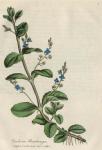
 Synonyma. Becabunga, Pharm. Lond. Curt. Flor. Lond.
Synonyma. Becabunga, Pharm. Lond. Curt. Flor. Lond.
Veronica foliis ovatis serratis glabris ex alis racemosa, Hal. Stirp. Helv. n. 534.
Anagallis Aquatica vulgaris sive Becabunga, Park. Theat. 1236.
Anagallis Aquatica minor, folio subrotundo. Bauh. pin. 252.
Anagallis seu Becabunga. Gerard, 620.
Class Diandria. Ord. Monogynia. L. Gen. Plant. 25.
Ess. Gen. Ch. Cor. Limbo 4-partito, lacinia infima augustiore. Capsula bilocularis.
** Corymboso-racemosa.
Spec. Char. V. racemis lateralibus, fol. ovatis planis, caule repente.
The root is perennial, creeping, jointed, and from each joint sends forth many long slender fibres; the leaves are thick, oval, smooth, obtusely serrated, of a pale-green colour, and stand upon the stem in pairs, either sessily, or upon very short footstalks; the stem is round, jointed, creeping, smooth, succulent, often of a reddish brown colour, and from eight to twelve inches high; the racemi or flower spikes, are lateral, opposite, bracteated, and terminated by the flowers, which are of a faint blue colour, and divided into four small roundish leaves; the calyx is quadripartite. This plant is very common in ditches and shallow streams.
The leaves and stem of Brooklime have a bitterish subastringent taste, but manifest little or no acrimony, nor any peculiar odour: by chemical experiments they appear to be subacid, and possess some degree of astringency; these qualities, however, are common to almost all fresh vegetables, and afford no proof of their medical powers.
This plant was formerly considered of much use in several diseases, and was applied externally to wounds and ulcers; but if it have any peculiar efficacy, it is to be derived from its antiscorbutic virtue. As a mild refrigerant juice it is preferred where an acrimonious state of the fluids prevails, indicated by prurient eruptions upon the skin, or in what has been called the hot scurvy; it is ordered in the London Pharmacopoeia as an ingredient in the succus cochliariae compositus, probably with a view to correct the pungency of the cress. Rutty says, "Succus ejus saponaceus est, aperiens, & majori copia sumptus, alvum movet commodissime." We must, however, acknowledge, that we should expect equal benefit from the same quantity of any other bland fresh vegetable matter taken into the system. To derive any advantage from it, the juice ought to be used in large quantities, or the fresh plant eaten as food.

